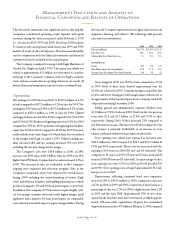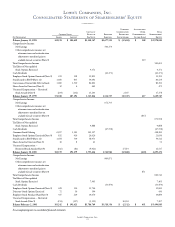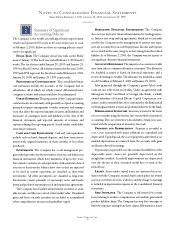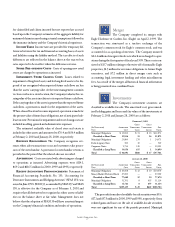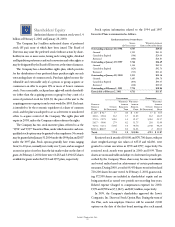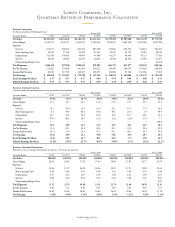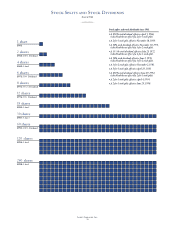Lowe's 2000 Annual Report Download - page 29
Download and view the complete annual report
Please find page 29 of the 2000 Lowe's annual report below. You can navigate through the pages in the report by either clicking on the pages listed below, or by using the keyword search tool below to find specific information within the annual report.
Lowe’s Companies, Inc.
27
for claims filed and claims incurred but not reported are accrued
based upon the Company’s estimates of the aggregate liability for
uninsured claims incurred using actuarial assumptions followed in
the insurance industry and the Company’s historical experience.
Income Taxes Income taxes are provided for temporary dif-
ferences between the tax and financial accounting bases of assets
and liabilities using the liability method. The tax effects of such
differences are reflected in the balance sheet at the enacted tax
rates expected to be in effect when the differences reverse.
Store Pre-opening Costs Costs of opening new retail
stores are charged to operations as incurred.
Impairment / Store Closing Costs Losses related to
impairment of long-lived assets and for long-lived assets to be dis-
posed of are recognized when expected future cash flows are less
than the assets’ carrying value. At the time management commits
to close or relocate a store location, the Company evaluates the car-
rying value of the assets in relation to its expected future cash flows.
If the carrying value of the assets is greater than the expected future
cash flows, a provision is made for the impairment of the assets.
When a leased location becomes impaired, a provision is made for
the present value of future lease obligations, net of anticipated sub-
lease income. Provisions for impairment and store closing costs are
included in selling, general and administrative expenses.
The estimated realizable value of closed store real estate is
included in other assets and amounted to $76.4and $56.4million
at February 2, 2001 and January 28, 2000, respectively.
Revenue Recognition The Company recognizes rev-
enues when sales transactions occur and customers take posses-
sion of the merchandise. A provision for merchandise returns is
provided in the period that the related sales are recorded.
Advertising Costs associated with advertising are charged
to operations as incurred. Advertising expenses were $114.1,
$69.2and $116.5million for 2000, 1999 and 1998, respectively.
Recent Accounting Pronouncements Statement of
Financial Accounting Standards No. 133, “Accounting for
Derivative Instruments and Hedging Activities” (SFAS 133), was
issued in June 1998. SFAS 133, as amended by SFAS 137 and SFAS
138, is effective for the Company as of February 3, 2001 and
requires that all derivatives be recognized as either assets or liabil-
ities in the balance sheet at fair value. Management does not
believe that the adoption of SFAS 133 will have a material impact
on the Company’s financial condition and results of operations.
Merger
The Company completed its merger with
Eagle Hardware & Garden, Inc. (Eagle) on April 2, 1999. The
transaction was structured as a tax-free exchange of the
Company’s common stock for Eagle’s common stock, and was
accounted for as a pooling of interests. The Company incurred
$24.4million of merger related costs which were charged to oper-
ations during the first quarter of fiscal year 1999. These costs con-
sisted of $15.7million relating to the write-off of nonusable Eagle
properties, $1.5million for severance obligations to former Eagle
executives, and $7.2million in direct merger costs such as
accounting, legal, investment banking and other miscellaneous
fees. As a result of the merger, all historical financial information
is being presented on a combined basis.
Investments
The Company’s investment securities are
classified as available-for-sale. The amortized cost, gross unreal-
ized holding gains and losses and fair values of the investments at
February 2, 2001 and January 28, 2000 are as follows:
February 2, 2001
Gross Gross
(In Thousands) Amortized Unrealized Unrealized Fair
Type Cost Gains Losses Value
Municipal Obligations
$ 12,836 $ 51 $ 16 $ 12,871
Classified as Short-Term
12,836 51 16 12,871
Municipal Obligations
23,800 276 1 24,075
Federal Agency Note
500 10 — 510
Corporate Notes
9,756 349 — 10,105
Classified as Long-Term
34,056 635 1 34,690
Total
$ 46,892 $686 $ 17 $ 47,561
January 28, 2000
Gross Gross
(In Thousands) Amortized Unrealized Unrealized Fair
Type Cost Gains Losses Value
Municipal Obligations
$ 10,668 $ 12 $ 10 $ 10,670
Money Market Preferred Stock
67,000 — — 67,000
Classified as Short-Term
77,668 12 10 77,670
Municipal Obligations
31,761 8 655 31,114
Classified as Long-Term
31,761 8 655 31,114
Total
$109,429 $ 20 $665 $108,784
The proceeds from sales of available-for-sale securities were $8.6,
$17.1and $37.5million for 2000, 1999 and 1998, respectively. Gross
realized gains and losses on the sale of available-for-sale securities
were not significant for any of the periods presented. Municipal
note
2
note
3




